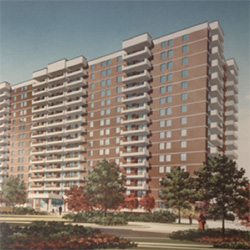The most important reason for smoke-free housing is clean indoor air. Second-hand smoke is more than a nuisance—it is a toxic mix of more than 7,000 chemicals.
Second-hand smoke travels due to differences in air pressure between units, between floors and between the inside and outside of a building. Second-hand smoke can transfer from a neighbour’s patio or balcony; through open windows or doors; through electrical outlets, cable or phone jacks, or ceiling fixtures; through cracks and gaps around sinks, countertops, windows, doors, floors, walls or dropped ceilings; and through the ventilation or forced air system.
Research has shown that up to 65% of the air in a unit can come from other units in the building.
There is no known safe level of exposure to second-hand smoke. Second-hand smoke is a serious problem for many Ontario residents living in multi-unit housing, especially those who have chronic health conditions. Second-hand smoke increases risk of heart disease and lung cancer and causes acute respiratory problems. It is especially harmful to seniors, children and pregnant people.
Ventilation
According to Health Canada, air purifiers, also referred to as portable air cleaners, can help improve indoor air quality by removing small particles that can be a health risk. While air purifier filters can help capture some pollutants (particles, pollen, dust), the best way to improve indoor air is to remove the source of the pollutants and to ventilate with clean, outdoor air. There is no ventilation system that can remove enough toxins to effectively protect human health from the dangers of second-hand smoke.
The American Society of Heating, Refrigeration and Air Conditioning Engineers (ASHRAE), the authority who sets internationally-recognized ventilation standards, issued a position statement on ventilation and environmental tobacco smoke (ETS), which stated “At present, the only means of effectively eliminating health risk associated with indoor exposure is to ban smoking activity.” In 2006 the US Surgeon General’s report on second-hand smoke stated that “the typical heating, cooling and exhaust systems found in most American homes are not capable of removing second-hand smoke particles.”
Third-hand Smoke
Read about thirdhand smoke.
Thirdhand smoke (THS) refers to residual second-hand tobacco smoke that persists after smoking has stopped. It can settle on walls, carpets, countertops, tile, upholstery and other surfaces. Chemicals in the smoke that are oily or waxy may be more likely to stick to surfaces than be removed by ventilation. Studies suggest that third-hand smoke can affect people’s health when they inhale (breathe in), touch surfaces or swallow particles.
How long thirdhand smoke persists in an indoor environment depends on:
- Number of cigarettes smoked
- Ventilation
- Type of furnishings and finishes (hard materials such as plastic and metal furniture versus soft materials such as fabric)
- Off-gassing (airborne release of a chemical in vapour form






